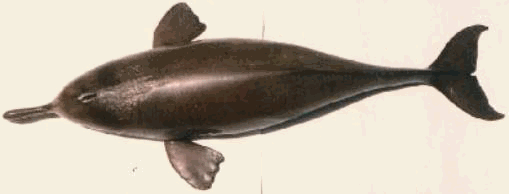
River Dolphin or Susu or Hihu or Platanista Gangetic (Scientific name):
The river dolphin is practically blind. The eyes does not have a lens so is incapable of forming images on the retina. However, it can sense light levels.
It is believed that the loss of sight in the river dolphin is related to its habitat, the water in which it lives is so muddy that the vision is essentially useless.
The river dolphin ranges from 2.3 to 2.6 meters in length. Females are larger than males. Color varies from lead-gray to black. The undersides are lighter
in colour, some almost pink. The rostrum is long and the forehead is steep and rises abruptly from the base of the snout. The neck is visibly constricted and the blowhole is longitudinal slit. There are 28 to 29 teeth on either side of the jaw.
Young are born year-around in this species, but most births occur between October and March. A significant birth peak takes place in December and January,
at the beginning of the dry season. Gestation lasts eight to nine months. The young are weaned and solitary before they are one year old. They reach sexual maturity in ten years, and individual dolphins studied have shown growth past the age of twenty-six.
Although the schools of three to ten individuals have been reported in particular parts of river systems, these animals are not gregarious and spend most
of their time feeding and traveling solitary. They swim all day and all night and continually emit sounds. One study showed that 81% of the sound are echolocation and 5% communication. Echolocation is used by the dolphins in the foraging and it helps these
animals to sense objects; they can detect a wire one millimeter in diameter. The river dolphin is found only in fresh water and may migrate locally to tidal waters during the monsoon season. During the hot, dry season the species disappears from the areas
of river systems where temperature, salinity, food limitation may cause conditions to be too severe.
The main threats to river dolphins are fragmentation of their habitat, increasing levels of pollution, depletion of their prey for human consumption, boat
traffic, and the perils posed by fishing equipment. In addition, river dolphins are sometimes killed for their product.Their meat is also used as bait for fishing, some people regard their oil as an aphrodisiac. In 1982, the total population of Ganges river
dolphins was estimated to be 4,000 – 5,000 animals. There are no recent estimates available.
(
This report was sent in byArjit Purkayastha, General Manager Tours, Net work Travels, Assam.)

photo Courtesy 'Outlook' September 10th 2001
The fresh water dolphin is an endangered species. Bihar's rivers are home to about 1000 dolphins. Prof. R.K Sinha ( rksinha@mail.girija.net.in ) runs the Dolphin foundation
with a six member team. The foundation educates and convinces people about the harmful fallout of killing dolphins. Prof. Sinha had a role in setting up of the Vikramshila Dolphin Sanctuary in Bhagalpur.
The river dolphin is found in India, Nepal, Bhutan and Bangladesh in the Brahmaputra, Ganges, Meghna,
Karnaphuli and Hoogli river.